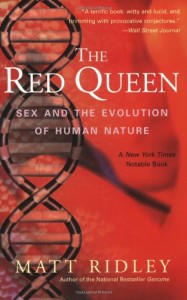 A little over a decade and a half ago, I went through puberty. I still remember how instantly priorities shifted, how my care-free childhood vanished and everything in life, every insecurity and aspiration, seemed to revolve around sex. A great deal has changed since then (or at least, so I’d like to believe…) but the more deeply I read in evolutionary biology, the more convinced I become that my adolescent intuitions about the world were disturbingly accurate. Sex, the greatest of our cultural taboos, really might be the key to understanding human beings, to a degree that would disquiet even the most hardened atheist.
A little over a decade and a half ago, I went through puberty. I still remember how instantly priorities shifted, how my care-free childhood vanished and everything in life, every insecurity and aspiration, seemed to revolve around sex. A great deal has changed since then (or at least, so I’d like to believe…) but the more deeply I read in evolutionary biology, the more convinced I become that my adolescent intuitions about the world were disturbingly accurate. Sex, the greatest of our cultural taboos, really might be the key to understanding human beings, to a degree that would disquiet even the most hardened atheist.
Matt Ridley’s The Red Queen synthesizes a great deal of research and insight into human evolutionary biology to ask one astonishingly simple question: why do human beings have sex? The question might strike you as absurd: we have sex because we evolved from primates who reproduce sexually. Sure, but Ridley asks: why sexual reproduction? If the goal is mere reproduction, having two distinct genders, each with different and vastly asymmetrical roles in reproduction, is clearly an inferior choice. After all, we might have evolved to reproduce asexually, which would both double our effective rate of reproduction (no need for men who can’t bear children) and assure a greater fidelity of gene replication. From a purely reproductive standpoint, sexual reproduction has glaring faults, faults that make parthenogenesis seem mighty attractive.
It is here that Ridley’s Red Queen concept comes into play. In Lewis Carroll’s Through The Looking Glass, the Red Queen character runs and runs and runs only “to keep in the same place.” Sexual reproduction, it turns out, is common among so-called “higher life forms,” those with longer life expectancies and slower generational advancement. Ridley posits that we are in an evolutionary arms race with bacteria, which are forever at war with our immune systems. In the lifetime of the average human being, the bacteria in our guts will have gone through some ten million generations. Each new generation of bacteria represents an evolution in the arms race, and hence a step closer to our destruction. Enter sexual reproduction. By reproducing sexually, human beings don’t merely transmit copies of their genes into the next generation; they achieve recombination, such that the child is a product of both parents’ DNA.
In terms of the evolutionary arms race, sexual reproduction resets the locks, if you will, throwing an entirely new combination at the would-be invaders. The longer an animal lives, the more time bacteria have to evolve to invade or kill it.
The consequences of sexual reproduction are immense and far-reaching. In that basic division of reproductive labor is found the risk/reward calculation for both genders and the basis for human civilization as we know it, and Ridley does an admirable job demonstrating how these constraints have played out. The Red Queen is eminently readable, just as much a work of journalism and storytelling as science, and every bit as deserving of its popularity.